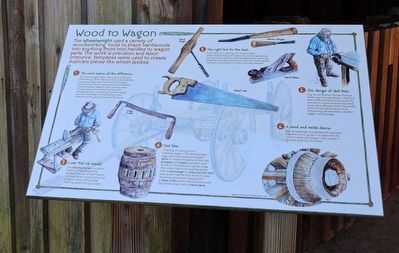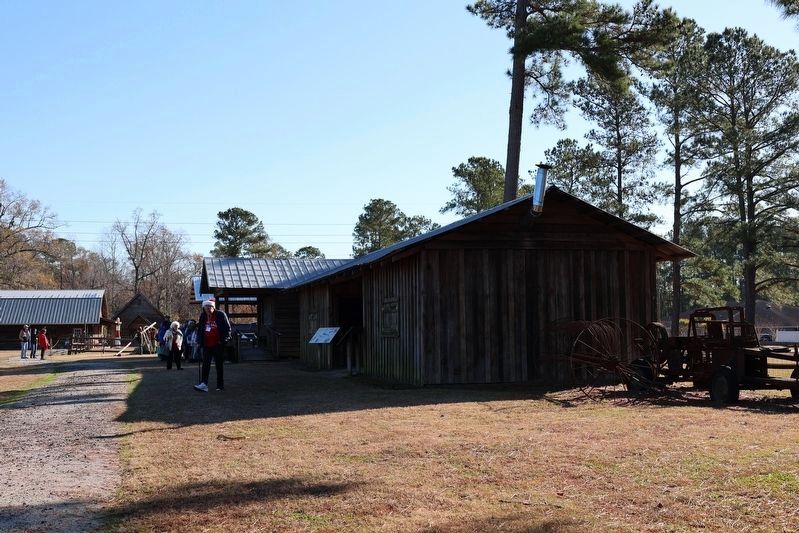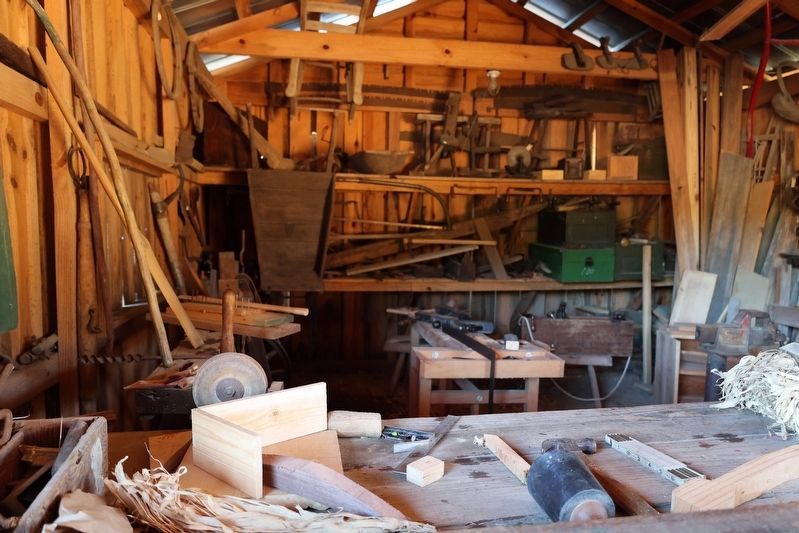Conway in Horry County, South Carolina — The American South (South Atlantic)
Wood to Wagon
— L.W. Paul Living History Farm —
1. The wood makes all the difference
The wheelwright began with a general length of hardwood from the local forest. Tool handles were generally made from ash or hickory because they have long grains and are flexible under pressure. Wagons were mostly made of oak because the wood is strong, rot-resistant, and can be heat-bent when soaked in water. The shape of the finished piece determined the general size and thickness.
2. Look Ma! No Hands!
The shaving horse is a simple machine that allows the worker the use of both hands to shave down a piece of wood. Pressure from a foot pedal held the wood firmly in place.
3. The right tool for the task
From sawing to planting, the wheelwright used a wide variety of custom tools to shape wood into workable parts. a wheelwright's shop had to be organized and dry. Moisture on the iron parts caused rust and could mold or rot the wooden handles.
4. Tool Time
A variety of tools go into making a wagon. The wheelwright may use a foot-operated treadle lathe to create the barrel of the hub. Gouges and chisels would be used to cut out the precision spoke holes. The center had to be expertly drilled with a hand auger or brace and bit drill. Each spoke that fits into the hub holes would be shaved and shaped with a draw knife and the flat boards would be shaved down with a hand plane.
5. The danger of dull tools
Any wood worker knows that his tools must be kept sharp. A dull tool was inefficient and could cause the workers to injure themselves. Small tools were sharpened on hand-held whet stones while hand-crank sharpening wheels were used for bigger cutting edges.
6. A wood and metal dance
The wheelwright and Blacksmith worked together piece by piece to assemble the custom parts of a wagon. One couldn't be done without the other.
Erected by L.W. Paul Living History Farm.
Topics. This historical marker is listed in these topic lists: Education • Industry & Commerce • Parks & Recreational Areas.
Location. 33° 54.308′ N, 79° 2.916′ W. Marker is in Conway, South Carolina, in Horry County. Marker can be reached from Harris Short Cut Road west of U.S. 170, on the right when traveling west. Touch for map. Marker is at or near this postal address: 2279 Harris Short Cut Rd, Conway SC 29526, United States of America. Touch for directions.
Other nearby markers. At least 8 other markers are within walking distance of this marker. Working Iron (here, next to this marker); Gristmill (a few steps from this marker); Making the Cut (a few steps from this marker); Raising Cane (within shouting distance of this marker); Raising Tobacco (within shouting distance of this marker); L.W. Paul Living History Farm (about 300 feet away, measured in a direct line); The Legacy of Farm to Table (about 300 feet away); Farm House (about 300 feet away). Touch for a list and map of all markers in Conway.
Also see . . . The L.W. Paul Living History Farm. Horry County Museum (Submitted on December 5, 2023.)
Credits. This page was last revised on December 5, 2023. It was originally submitted on December 4, 2023, by Sandra Hughes Tidwell of Killen, Alabama, USA. This page has been viewed 47 times since then and 13 times this year. Photos: 1, 2, 3. submitted on December 4, 2023, by Sandra Hughes Tidwell of Killen, Alabama, USA. • Bernard Fisher was the editor who published this page.


